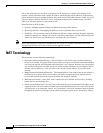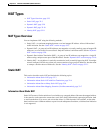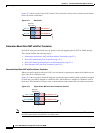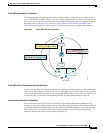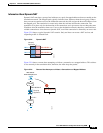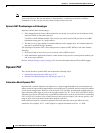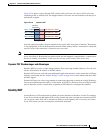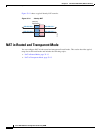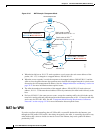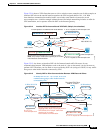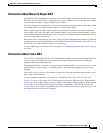
32-10
Cisco ASA 5500 Series Configuration Guide using ASDM
Chapter 32 Information About NAT (ASA 8.3 and Later)
NAT Types
Note For the duration of the translation, a remote host can initiate a connection to the translated host if an
access rule allows it. Because the address is unpredictable, a connection to the host is unlikely.
Nevertheless, in this case you can rely on the security of the access rule.
Dynamic NAT Disadvantages and Advantages
Dynamic NAT has these disadvantages:
• If the mapped pool has fewer addresses than the real group, you could run out of addresses if the
amount of traffic is more than expected.
Use PAT or a PAT fallback method if this event occurs often because PAT provides over 64,000
translations using ports of a single address.
• You have to use a large number of routable addresses in the mapped pool, and routable addresses
may not be available in large quantities.
The advantage of dynamic NAT is that some protocols cannot use PAT. PAT does not work with the
following:
• IP protocols that do not have a port to overload, such as GRE version 0.
• Some multimedia applications that have a data stream on one port, the control path on another port,
and are not open standard.
See the “Default Settings” section on page 46-4 for more information about NAT and PAT support.
Dynamic PAT
This section describes dynamic PAT and includes the following topics:
• Information About Dynamic PAT, page 32-10
• Dynamic PAT Disadvantages and Advantages, page 32-11
Information About Dynamic PAT
Dynamic PAT translates multiple real addresses to a single mapped IP address by translating the real
address and source port to the mapped address and a unique port. If available, the real source port number
is used for the mapped port. However, if the real port is not available, by default the mapped ports are
chosen from the same range of ports as the real port number: 0 to 511, 512 to 1023, and 1024 to 65535.
Therefore, ports below 1024 have only a small PAT pool that can be used. (8.4(3) and later, not including
8.5(1) or 8.6(1)) If you have a lot of traffic that uses the lower port ranges, you can now specify a flat
range of ports to be used instead of the three unequal-sized tiers.
Each connection requires a separate translation session because the source port differs for each
connection. For example, 10.1.1.1:1025 requires a separate translation from 10.1.1.1:1026.



